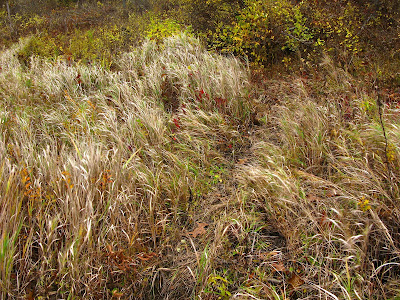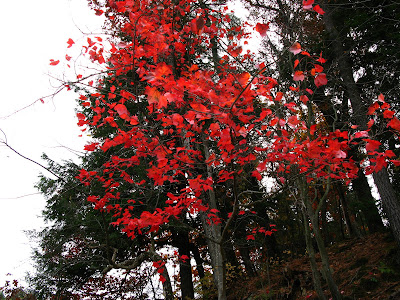After too many days that were windy and cold, and others when it rained and rained, today seemed like a pure gift: balmy, no wind, a light that was soft and shadowless. Perfect for a walk all the way around Moreau Lake. Except for spots where fallen trees impeded my path, or mud sucked at my shoes, I kept very close to the water's edge, enjoying the feel of soft sand beneath my feet and the splendid vistas of forested mountains reflected in the still water of the lake.

Yes, the autumn leaves are "past peak," but gorgeous color still abounds. All the oaks are now coming into their glory, and though most are some variation on the color brown, some are as vivid as a radiant sunset
and others as deeply scarlet as any Red Maple.
Maple-leaved Viburnum still glows with its unique shade of coral, its berries now such a deep shade of blue they look black.
The poplars may have shed their leaves, but their beauty remains, scattered about on the ground among evergreen leaves of Periwinkle.
I saw Mallard ducks and Canada Geese on the lake today, and even if I hadn't actually seen any waterfowl, I could have surmised their presence here by the feathers floating among the lily pads.
Other evidence of the lake's resident creatures included this downed willow log, arrayed like a beavers' buffet. Can't you just see them gnawing away, positioned shoulder to shoulder? It's kind of a mystery to me why they do this. I thought they ate only bark and young twigs. In fact, all the wood chips remain in piles beneath the log. Are the beavers just chewing for fun?
I saw this small finch-like bird flitting about the beach, and I couldn't identify it. After searching through my bird books at home, I still don't know what it is. I wonder if it's in the process of changing its plumage and so doesn't match any pictures in the book. I'll bet my friend Lindsey will know.
Speaking of small flitting things, how about this furry little baby-blue fly? Park staffer Dave Alfred snatched it out of the air so I could take a photo. Not a very good one, I'm afraid, since this fly is very tiny -- less than a quarter inch -- and didn't exactly hold still for its portrait. I posted the photo on BugGuide.net and await an identification. One responder thought it might be a Wooly Aphid, but then had second thoughts. Whatever it is, it's pretty cute.
Another thing Dave showed me was this Ravenel's Stinkhorn mushroom that had sprouted near the park headquarters. And stink it certainly did! Phew! It has a Latin name (Phallus ravenelii) that's pretty descriptive of its shape and size. (Be sure to check the comments to this post, where SueP tells us what Thoreau had to say about this fungus, and I quote an entomologist enamored of Wooly Alder Aphids.)
A much tinier fungus is Multiclavula mucida, less than a centimeter tall and very slender. Its common name is Green-algae Coral, and a very descriptive name it is, since I found it growing on a dead log that was covered with moss and green algae. My mushroom guides tell me this fungus is always associated with green algae.
Speaking of green, there were lots of pretty green things growing around the lake today. Because it is still green, I'm guessing this is a Wood Fern, which, along with Christmas Fern, is a fern that stays green all winter.

And because of the placement of its fruit dots (called Sori) along the margins of the fern's pinnae, I'm guessing this is a Marginal Wood Fern. But I'm no expert at IDing ferns. If somebody knows for sure, please let us know.
Pitch Pine is, of course, an evergreen. But today, some of its needles were turning yellow and falling off. Nothing's wrong, that's just what it does as it replaces old needles with new. Its cones are closed up tight and they'll stay that way unless a fire comes along and scorches them. Only then do they spill their seeds on the burned-over ground. I wonder if Red Squirrels can pry them out of the tight-closed cones.
Here's another evergreen tree and its cones: White Cedar. Also called Arbor Vitae. I always pinch its branches as I pass by, releasing its wonderful fragrance.
Pearly Everlasting has flowers that remind me of some kind of evergreen cones. Even when they are newly opened, they feel like they're made of dry husks. And now that their leaves are all dried and shriveled, the blossoms still look the way they did many weeks ago. I guess that's why they're called "everlasting."

That rich red color behind the Everlasting blooms comes from masses of Low Blueberry lining the shore. When I set out for Moreau, I almost didn't bring my camera with me, thinking there might not be anything very colorful to photograph today. Silly me.




















































